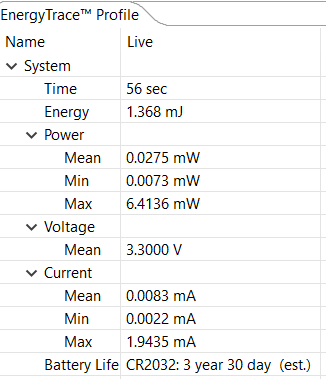SLAAEF5 March 2024 MSPM0G1505 , MSPM0G1505 , MSPM0G1506 , MSPM0G1506 , MSPM0G1507 , MSPM0G1507 , MSPM0L1303 , MSPM0L1303 , MSPM0L1304 , MSPM0L1304 , MSPM0L1304-Q1 , MSPM0L1304-Q1 , MSPM0L1305 , MSPM0L1305 , MSPM0L1305-Q1 , MSPM0L1305-Q1 , MSPM0L1306 , MSPM0L1306 , MSPM0L1306-Q1 , MSPM0L1306-Q1
- 1
- Abstract
- Trademarks
- 1Introduction
- 2Algorithm Introduction
- 3Gauge GUI Introduction
- 4MSPM0 Gauge Evaluation Steps
- 5MSPM0 Gauge Solutions
- 6References
5.1.3.2 Current Consumption Test
As the MSPM0 Gauge board mostly focuses on evaluating the function and doesn’t consider how to optimize the power consumption. The current tested based on the Gauge board will be a little high. To optimize it, you need to remove the tantalum capacitor, connect the temperature sensor to GPIO as the GND, and increase the voltage divider resistors.
Here is the current test result, under NO_OUTPUT mode, and removes the tantalum capacitor, the temperature sensor, and voltage divider resistors.
 Figure 5-10 Current Consumption
Figure 5-10 Current Consumption